Bounty Hunter Treasure Owner's manual
- Category
- Measuring, testing & control
- Type
- Owner's manual

ACC ESSORIES
FOR COMPLETE DETAILS VISIT WWW.DETECTING.COM • 1-800-413-4131
Carry Bag ......
$ 29.95
Rugged double-stitched construction - CBAG-W
Pouch & Digger Combo ......
$ 24.95
Pouch with 2 large pockets & 9” heavy duty digging tool. TP-KIT-W
Bounty Hunter Stereo Headphones
......
$ 39.95
Use with Bounty Hunter metal detectors. Lightweight and adjustable with
true stereo sound, adjustable volume, 1/8 jack with 1/4 adaptor,
4’ cable.
HEAD-W
Pin Pointer ......
$ 69.95
Pinpoints the exact location of buried metal objects. Audio signal indicator
and vibrator. Runs on 1 – 9-Volt Battery. PIN POINTER-W
Sand Scoop......
$ 24.99
Large scoop with filtering holes. Made of strong plastic. SAND SCOOPBH
Replacement/Accessory Search Coils
10” Magnum Coil – 10COIL…………………
$69.95
7” Replacement Standard Coil – 7COIL-VLF……
$49.95
4” Gold Nugget Coil – 4COIL…………………
$39.95
Coil Covers
Protect your coil from abrasion and damage.
10” Coil Cover – 10COVER…………………
$19.99
7X3/4” Coil Cover – 7X3/4COVER……..…...
$19.99
4” Coil Cover – 4COVER…………………
$14.99
9” Heavy-Duty Digging Tool
......
$ 10.95
Metal blade with comfortable plastic handle and depth gauge TROWEL-2
Digging Tool ......
$ 7.95
Light and practical wide blade digging tool. TROWEL-W
Bounty Hunter Apron......
$ 5.95
Natural canvas with 2 large pockets. APRN-BH
Bounty Hunter T-Shirt
......
$ 19.99
100% cotton with Bounty Hunter
®
Logo. Sizes – LG, XL & XXL
Bounty Hunter Baseball Cap
......
$ 14.95
One size fits all, with Bounty Hunter
®
logo.
Gold
Prospecting Kits
$ 29.99 $ 59.99 $ 109.99
OWNER’S MANUAL
The
Cabela’s
Treasure
Hunter is a
professional metal detector. While
the most difficult aspects of metal
detecting have been automated, it is a
sophisticated electronic device which
requires an understanding of some basic
features and metal detecting concepts.
If you do not have prior experience with a metal
detector, we strongly recommend that you:
1) Adjust the Sensitivity to a low setting in
the event of false signals.
Always begin use at a reduced
sensitivity level; increase to full sensitivity after you have become
familiar with the detector.
2) Do not use indoors. This detector is for outdoor use only. Many
household appliances emit electromagnetic energy, which can
interfere with the detector. If conducting an indoor demonstration,
turn the sensitivity down and keep the search coil away from
appliances such as computers, televisions and microwave ovens.
If your detector beeps erratically, turn off appliances and lights,
especially those with dimmer switches.
Also keep the search coil away from objects containing metal, such
as floors and walls.
3) Read this manual. Most importantly, review the Quick-Start Demo
(p.6 & 7) and Basic Operation (p. 8-11).
4)
Use 9-volt ALKALINE batteries only. Do not use Heavy Duty
Batteries.
MTH Rev.2 050311

2
TABLE OF CONTENTS
Terminology . . . . . . . . . . . . . . . . . . . . . . . . . . . .3
Assembly . . . . . . . . . . . . . . . . . . . . . . . . . . . . . .4
Batteries . . . . . . . . . . . . . . . . . . . . . . . . . . . . . . .5
Quick-Start Demo . . . . . . . . . . . . . . . . . . . . . .6-7
Basic Operation . . . . . . . . . . . . . . . . . . . . . . 8-11
Powering Up . . . . . . . . . . . . . . . . . . . . . . . .8
Sensitivity . . . . . . . . . . . . . . . . . . . . . . . . . .8
All Metal . . . . . . . . . . . . . . . . . . . . . . . . . . .9
Discrimination . . . . . . . . . . . . . . . . . . . . 9-10
Notch . . . . . . . . . . . . . . . . . . . . . . . . . . . .10
Headphones . . . . . . . . . . . . . . . . . . . . . . .11
Audio Target Identification . . . . . . . . . . . . . . .12
Depth and Target Display . . . . . . . . . . . . . . . . .13
Sensitivity Adjustment . . . . . . . . . . . . . . . . . . .14
In The Field Techniques . . . . . . . . . . . . . . .15-17
Trouble Shooting . . . . . . . . . . . . . . . . . . . . . . .18
Treasure Hunter’s Code of Ethics . . . . . . . . . . .19
Warranty
. . . . . . . . . . . . . . . . . . . . . . . . . . . . .19
Accessories
. . . . . . . . . . . . . . . . . . . . .Back Cover
5-YEAR LIMITED WARRANTY
The Teasure Hunter metal detector is warranted against defects in materials and
workmanship under normal use for five years from the date of purchase to the origi-
nal owner.
Damage due to neglect, accidental damage, or misuse of this product is not cov-
ered under this warranty. Decisions regarding abuse or misuse of the detector
are made solely at the discretion of the manufacturer.
Proof of Purchase is required to make a claim under this warranty.
Liability under this Warranty is limited to replacing or repairing, at our option, the
metal detector returned, shipping cost prepaid to First Texas Products. Shipping
cost to First Texas Products is the responsibility of the consumer.
To return your detector for service, please first contact First Texas for a Return
Authorization (RA) Number. Reference the RA number on your package and
return the detector within 15 days of calling to:
First Texas Products L.L.C.
1465-H Henry Brennan Dr.
El Paso, TX 79936
Phone: 915-225-0333
NOTE TO CUSTOMERS OUTSIDE THE U.S.A.
This warranty may vary in other countries, check with your distributor for details.
Warranty does not cover shipping costs.
According to FCC part 15.21 Changes or Modifications made to this device not expressly approved by
the party responsible for compliance could void the users authority to operate this equipment.
Copyright
©
2010 by First Texas Products, L.L.C.
All rights reserved, including the right to reproduce this book, or parts thereof, in any form,
except for the inclusion of brief quotations in a review.
Published by First Texas Products, L.LC.
Bounty Hunter
®
is a registered trademark of First Texas Products, L.L.C.
www.detecting.com
1465-H Henry Brennan • El Paso, TX 79936 • (915) 633-8354
TREASURE HUNTER’S CODE OF ETHICS:
• Always check Federal, State, County and local laws before searching.
• Respect private property and do not enter private property without the owner’s permission.
• Take care to refill all holes and leave no damage.
• Remove and dispose of any and all trash and litter found.
• Appreciate and protect our inheritance of natural resources, wildlife and private property.
• Act as an ambassador for the hobby, use thoughtfulness, consideration and courtesy at all times.
• Never destroy historical or archaeological treasures.
• All treasure hunters may be judged by the example you set; always conduct yourself with
courtesy and consideration of others

3
TERMINOLOGY
The following terms are used throughout the manual, and are standard
terminology among detectorists.
ELIMINATION
Reference to a metal being "eliminated" means that the detector will
not emit a tone, nor light up an indicator, when a specified object
passes through the coil’s detection field.
DISCRIMINATION
When the detector emits different tones for different types of metals,
and when the detector "eliminates" certain metals, we refer to this
as the detector "discriminating" among different types of metals.
Discrimination is an important feature of professional metal
detectors. Discrimination allows the user to ignore trash and
otherwise undesirable objects.
RELIC
A relic is an object of interest by reason of its age or its association
with the past. Many relics are made of iron, but can also be made
of bronze or precious metals.
IRON
Iron is a common, low-grade metal that is an undesirable target in
certain metal detecting applications. Examples of undesirable iron
objects are old cans, pipes, bolts, and nails.
Sometimes, the desired target is made of iron. Property markers,
for instance, contain iron. Valuable relics can also be composed of
iron; cannon balls, old armaments, and parts of old structures and
vehicles can also be composed of iron.
FERROUS
Metals which are made of, or contain, iron.
PINPOINTING
Pinpointing is the process of finding the exact location of a buried
object. Long-buried metals can appear exactly like the surrounding
soil, and can therefore be very hard to isolate from the soil.
PULL-TABS
Discarded pull-tabs from beverage containers are the most bothersome
trash items for treasure hunters. They come in many different shapes
and sizes. Pull-tabs can be eliminated from detection, but some other
valuable objects can have a magnetic signature similar to pull-tabs, and
will also be eliminated when discriminating out pull-tabs.
GROUND BALANCE
Ground Balancing is the ability of the detector to ignore, or "see
through," the earth’s naturally occurring minerals, and only sound
a tone when a metal object is detected. The Treasure Hunter
incorporates proprietary Squelch-Tech® circuitry to eliminate false
signals from severe ground conditions
18
TROUBLESHOOTING GUIDE
SYMPTOM CAUSE SOLUTION
Detector chatters • Using detector • Use detector
or beeps erratically indoors outdoors only
• Using detector near • Move away
power lines
from power lines
• Using 2 detectors in • Keep 2 detectors
close proximity at least 20’ apart
• Highly oxidized • Only dig up
buried object repeatable
signals
• Environmental •
Reduce sensitivity
electromagnetic until erratic
interference signals cease
Constant low tone •
Discharged batteries
• Replace batteries
or
constant repeating
tones
• Wrong type of • Use only 9V
batteries alkaline batteries
LCD does not lock • Multiple targets •
Move coil slowly
on to one target ID present at different angles
or detector emits • Highly oxidized • Only dig up
multiple tones target
repeatable signals
• Sensitivity set • Reduce sensitivity
too high
No power, no • Dead batteries • Replace batteries
sounds
• Cord not connected •
Check connections
securely
TROUBLESHOOTING

4
ASSEMBLY
17
you are new to the hobby, you
may want to dig all targets at first.
With practice in the field, you will
learn to better discern the nature
of buried objects by the nature of
the detector’s response.
You may encounter some false
signals as you proceed. False
signals occur when the detector
beeps, but no metal target is
present. False signals can be
induced by electromagnetic
interference, oxidation, or
highly mineralized ground
soils. If the detector beeps
once, but does not repeat the
signal with several additional
sweeps over the same spot,
there is probably no target
present.
When searching very trashy
ground, it is best to scan small
areas with slow, short sweeps.
You will be surprised just how
much trash metal and foil you will
find in some areas. The trashiest
areas have been frequented by
the most people, and frequently
hold the most promise for finding
the most lost valuables.
Also maintain the search coil
positioned just above the surface
of the ground, without making
contact with the ground. Making
contact with the ground can cause
false signals.
IN THE FIELD TECHNIQUES
(continued)
Knu
rle
d
Kno
b
Nut
Screw
Cabl
e
Plug
Hand-grip
S-Rod
Armrest
Search
Coil
Cable
Sea
rch
Co
il
Assembly is easy and
requires no tools.
Just follow these steps:
●
1 Using the supplied bolt and
knurled knob, attach the search
coil to the lower stem.
●
2 Press the button on the upper
end of the lower stem and slide
the lower stem into the upper
stem.
Adjust the stem to a length that lets
you maintain a comfortable upright
posture, with your arm relaxed at your
side.
●
3 Wind the search coil cable
around the stem. Leave enough
slack in the cable to let you ad-
just the coil when you are
hunting on uneven ground.
Then tighten the knob at the
end of the search coil.
Note:
To adjust the coil,
simply loosen the knob.
●
4 Insert the coil’s plug into the
matching connector on the con-
trol housing. Be sure the holes
and pins line up correctly.
Caution:
• Do not force the plug in.
Excess force will cause damage.
• To disconnect the cable, pull out
the plug.
Do not pull on the cable.
Lower
Stem
Upper
Stem
Bottom view
Connector
on back of
control housing

516
Swing the search coil slowly,
overlapping each sweep as you
move forward. It is important to
sweep the coil at a consistent
speed over the ground as you
search. After identifying a target,
your sweep technique can help in
identifying both the location and
the nature of the target. If you
encounter a weak signal, try
moving the coil in short, rapid
sweeps over the target
zone; such a short
rapid sweep may
provide a more
consistent target
identification.
Most worthwhile objects will
respond with a repeatable tone.
If the signal does not repeat after
sweeping the coil directly over the
suspected target a few times, it is
more than likely trash metal.
Crossing the target zone with
multiple intersecting sweeps at
multiple angles is another way to
verify the repeatability of the
signal, and the potential of the
buried target. To use this method,
walk around the target area in a
circle, sweeping the coil across the
target repeatedly, every 30 to 40
degrees of the circle, about ten
different angles as you walk
completely around the target. If a
high-tone target completely
disappears from detection at a
given angle, chances are that you
are detecting oxidized ferrous
metals, rather than a silver or
copper object. If the tone changes
at different angles, you may have
encountered multiple objects. If
IN THE FIELD TECHNIQUES
(continued)
WHAT
READS
LIKE THIS
…MAY
ACTUALLY
BE THIS
Use ALKALINE
batteries only.
To install the
batteries:
●
1 Remove the
battery cover by
disengaging the
clip at the back.
●
2 Align the polarity
of the batteries
correctly, with
the positive "+"
toward the coil
plug connection,
as indicated by
the + and –
indicators on the
housing.
●
3 Insert (2) 9-Volt ALKALINE batteries, with the contacts pointed inward,
and press down on the back of the batteries to snap them into place.
Some brands of batteries will require moderate force to clear the
retaining tabs.
●
4 Replace the battery door.
Most metal detector problems are due to improperly installed
batteries, or the use of non-alkaline or discharged batteries.
If the
detector does not turn on, please check the batteries.
BATTERIES

15
IN THE FIELD TECHNIQUES
PINPOINTING
Accurate pinpointing takes practice
and is best accomplished by
“X-ing” the target area.
1. Once a buried target is indicated
by a good tone response,
continue sweeping the coil over
the target in a narrowing
side-to-side pattern.
2. Take visual note of the place on
the ground where the “beep”
sounds.
3. Stop the coil directly over this
spot on the ground.
4. Now move the coil straight
forward and straight back
towards you a couple of times.
5. Again make visual note of the
spot on the ground at which
the “beep” sounds.
6. If needed, “X” the target at
different angles to “zero in” on
the exact spot on the ground at
which the “beep” sounds.
COIL MOVEMENT
When swinging the coil, be
careful to keep it level with the
ground about one inch from the
surface. Never swing the coil like
a pendulum.
CORRECT
WRONG
When pinpointing a target, try drawing an “X”,
as illustrated, over where the tone is induced.
6
Q
UICK-START DEMONSTRATION
I. Supplies Needed
• A Nail • A Quarter
• A Pull-Tab from a beverage can • A Zinc Penny (dated after 1982)
II. Position the Detector
a. Place the detector on a
table, with the search coil
hanging over the edge.
(or better, have a friend
hold the detector, with
the coil off the ground)
b. Keep the search coil
away from walls, floors,
and metal objects.
c. Remove watches, rings and other jewelry or metal objects from
hands and wrists.
d. Turn off appliances or lights that cause electromagnetic
interference.
e. Pivot the search coil back
toward the detector body.
III. Power Up
Press the POWER touchpad.
IV. Wave each Object over the
Search Coil
a.Notice a different tone for each object.
Bass Tone: Nail
Low Tone: Pull-Tab
Medium Tone: Zinc Penny
High Tone: Quarter
b.Motion is required. Objects must be in motion over the
search coil to be detected.
V. Press the DISC A-M touchpad
The detector will beep twice
and an “R” will appear under
the iron indicator.

7
14
ELECTROMAGNETIC
INTERFERENCE
The principle use for the
Sensitivity Control is to
eliminate Electromagnetic
Interference (EMI).
A hobby metal detector is an
extremely sensitive device;
the search coil creates its
own magnetic field and acts
like an antenna. If your
detector beeps erratically
when the search coil is
motionless, the unit is probably detecting another electromagnetic field.
Common sources of EMI are electric power lines, both suspended and
buried, motors, and household appliances like computers and
microwave ovens. Some indoor electronic devices, such as dimmer
switches used on household lighting, produce severe EMI and can cause
the detector to beep erratically. Other metal detectors also produce their
own electromagnetic fields; so if detecting with a friend, keep two metal
detectors at least 20 feet apart.
If the detector beeps erratically,
REDUCE THE SENSITIVITY by
pressing the Sensitivity
▼ Pad on the left of the control panel.
SEVERE GROUND CONDITIONS
A secondary use for the Sensitivity Control is to reduce false detection
signals caused by severe ground conditions. While your Treasure Hunter
contains circuitry to eliminate the signals caused by most naturally
occurring ground minerals, 100% of all ground conditions cannot be
anticipated. Highly magnetic soils found in mountainous and gold-
prospecting locations can cause the detector to emit tones when metal
objects are not present. High saline content soils and sands can
sometimes cause the detector to false.
If the detector emits false, non-repeatable, signals, REDUCE THE
SENSITIVITY.
MULTIPLE TARGETS
If you suspect the presence of deeper targets beneath a shallower target,
reduce the sensitivity to eliminate the detection of the deeper targets, in
order to properly locate and identify the shallower target.
SENSITIVITY ADJUSTMENT
VI. Wave the Nail over
the Search Coil
a. The Nail will not be
detected.
b. The Nail has been
"Discriminated Out."
VII. Press the
“DISCRIMINATION-
▲”
touchpad twice.
Three “R”s are now
displayed.
VIII. Wave all objects over the Search Coil
The Nail and Pull-Tab will not be detected.
The other objects will be detected with their own distinctive tones.
IX. Press the NOTCH touchpad.
A flashing “R” will appear under the 5¢/PT segment.
X. Press the DISCRIMINATION ▲ touchpad three times.
The flashing “R” will move
to the ZINC segment.
XI. Press the NOTCH
touchpad again.
The “R” will appear under
zinc.
XII. Wave the zinc penny over the
search coil.
The penny is discriminated out.
XIII. Press the DISC A-M touchpad
The detector returns to ALL-METAL mode. No “R”s are displayed.
All types of metals will be detected.
XIV. Wave the Zinc Penny over the
search coil again.
The zinc penny (the most
recently detected item) is
eliminated from detector.
Q
UICK-START DEMONSTRATION
(continued)

8 13
DEPTH AND TARGET DISPLAY
READING THE DISPLAY
The Liquid Crystal Display (LCD) shows
the PROBABLE identification of the
targeted metal, as well as the PROBABLE
depth of the target, in inches.
The detector will register a repeating,
unchanging target identification when a
buried target has been located and
identified. If, upon repeated passes over
the same spot, the target identification
reads inconsistently, the target is probably
a trash item, or oxidized metal. With
practice, you will learn to unearth only the
repeatable signals.
The segment identifications are highly
accurate, when detecting the objects
described on the label. However, if you
register in a given category for an unknown
buried object, you could be detecting a
metallic object other than the object
described on the label, but with the same
metallic signature. Also, the greater the
distance between the target and the coil,
the less accurate the target identification.
GOLD TARGETS Gold objects will
register on the left side of the LCD scale.
Gold flakes will register under Iron/Foil
Small gold items will register under PT.
Medium-sized gold items will register
under S-cap.
Large gold items will register under Zinc.
SILVER TARGETS: Silver objects will
register to the right of the scale, under
25¢, 50¢, or $1, depending on the size
of the object. The larger the object, the
farther to the right it will register.
IRON/FOIL: All sizes of iron and
aluminum objects will register on the
far-left side of the scale. This could
indicate a worthless item such as a nail,
or a more valuable historic iron relic.
PT (pull tab): All older pull tabs from
beverage cans will register here. Some
newer pull tabs will register here. Many
gold rings will also register here.
S-CAP: Older screw caps from glass
bottles will register here. Large gold
rings, like a class ring, could also register
here. Some non-U.S. coins of recent
vintage will also register here.
ZINC: Newer pennies (post-1982) will
register here. Many non-U.S. coins of
recent vintage will also register here.
10¢: Dimes and pre-1982 pennies will
register here. Older, pre-1982, pennies
are composed of copper, which has a
metallic signature similar to a dime.
Caution: The target indications are visual
references. Many other types of metal
can fall under any one of these
categories. While the Treasure Hunter
will eliminate or indicate the presence of
most common trash items, it is
impossible to accurately classify ALL
buried objects.
DEPTH INDICATOR:
The Depth Indicator is accurate for
coin-sized objects. It indicates the
depth of the target, in inches. Large
and irregularly-shaped objects will
yield less reliable depth readings
When passing over an object, the
depth indicator will light up and stay
illuminated until another object is
scanned. Repeated indication at the
same depth level indicates an accurate
target detector. If the depth indication
varies with each sweep, try sweeping
at different angles; there may be more
than one target present. With practice,
you will learn the difference between
accurate readings, multiple targets,
and highly erratic readings which
evidence trash or irregularly shaped
objects.
BASIC OPERATION
POWERING UP
Press the POWER touch pad.
• The detector will beep 4 times
• All display segments will illuminate momentarily
• The SENSITIVITY and BATTERY indicators will
stay illuminated
SENSITIVITY
The detector’s default sensitivity will be indicated with two segments.
At this setting, the detector will detect a coin-sized object, such as a
quarter, buried approximately seven inches deep. To change the
sensitivity level, and thus the detection depth, press the SENSITIVITY
▲ or ▼ keys.
CAUTION:
At higher sensitivity levels, the detector is susceptible to electromagnetic
interference from electronic devices. Reduce sensitivity if demonstrating
indoors or if using near power lines or electrical equipment.
Reduce sensitivity if detector emits false signals

AUDIO TARGET IDENTIFICATION
While the LCD (Liquid Crystal Display) is very accurate in identifying
buried objects, the user in the field does not always maintain the display
screen in his field of vision. Therefore, we have incorporated an audio
feedback mechanism to alert the user to the nature of buried objects.
This audio feedback system first alerts the user to the presence and
classification of objects, whose nature and location can be confirmed
using the LCD display.
The detector can sound four different tones, depending on the object
detected.
BASS TONE
Ferrous objects, such as iron and steel, will induce a bass tone.
The smallest gold objects can also induce a bass tone.
LOW TONE
Pull-Tabs, nickels & smaller gold
MEDIUM TONE
Newer pennies (post-1982), larger gold objects, zinc, small brass
objects, and most bottle screw caps will induce medium tones.
Many recent vintage foreign currencies will induce medium
tones.
HIGH TONE
Silver and copper coins, larger brass objects, older pennies (pre-
1982), and highly oxidized metals will induce high tones.
Quarters, dimes and other precious coins fall into this category.
Audio Target Identification (ATI) classifies metals into four categories.
BASS TONE
Nails, Iron Objects,
& Smallest Gold Objects
LOW TONE
Pull Tabs, Nickels,
& Smaller Gold
MEDIUM TONE
Zinc Pennies (Post
1982), Larger Gold
Objects, Many screw
caps
HIGH TONE
Copper, Silver & Brass
Copper Pennies (Pre
1982)
12 9
DEFAULT OPERATION
The detector defaults to ALL METAL mode after powering on. In this
mode, all types of metals will be detected. An object’s probable
identification is indicated by the arrows at the top of the display. In
addition, the probable depth of coin-sized objects is indicated by the
large numeric indicator in the center of the display. All detected
objects will cause the depth indicator to illuminate. The depth
indication is not accurate for
larger objects; however, it will
provide accurate relative
depth indications. The
greater the distance an object
is from the search coil, the
greater its depth value.
DISC/ A-M Touch Pad
Pressing this touch pad will
cause the detector to toggle
between two operating
modes, DISCRIMINATION
and ALL-METAL. If the
detector is in the ALL-METAL
mode (the default mode), pressing the touch pad will change the
detector into DISCRIMINATION mode. If the detector is in the
DISCRIMINATION mode, pressing the touch pad will change the
detector into ALL-METAL mode.
DISCRIMINATION MODE
Discrimination is used to eliminate unwanted objects from detection.
To enter this mode, from ALL-METAL mode, press the DISC/A-M touch pad.
After pressing DISC/A-M, the detector will:
• Beep twice
• Display an "R" under the left-most segment, Iron
Ferrous objects will not be detected in DISCRIMINATION mode.
Heavily oxidized ferrous objects will sometimes, however, be
detected, usually with a high tone and an indication to the right of
the target identification scale.
BASIC OPERATION
(continued)

11
BASIC OPERATION
continued
HEADPHONES
Using headphones (not included) with your metal detector makes it
easier to identify subtle changes in the threshold levels for better
detection results, and also reduces drain on the batteries. The
Treasure Hunter Metal Detector has a stereo headphone jack located
at the rear of the case.
This device is to be used with interconnecting cables/headphone cables
shorter than three meters.
10
To increase the level of discrimination, press the DISCRIMINATION ▲
touch pad. Each time the ▲ pad is depressed, an additional "R" will
appear, thus eliminating from detection the objects which fall into the
corresponding categories.
To decrease the level of discrimination, press the DISCRIMINATION
▼
touch pad. Each time the ▼ pad is depressed, an illuminated "R" will
disappear, thus returning to detection the objects which fall into the
corresponding categories.
Discrimination Mode is a fixed-start-point elimination system. Objects
are cumulatively eliminated as the level of discrimination increases.
NOTCH MODE
To selectively eliminate a category from detection within the metallic
spectrum, use the NOTCH Mode.
Technical Note:
The NOTCH touch pad causes the status of an "R" segment to
toggle between ON and OFF.
To use the NOTCH Mode:
The NOTCH touch pad can be depressed at any time. But for
first-time use, place the detector in ALL-METAL mode.
A first demonstration is best accomplished as follows:
1) Turn the power OFF.
2) Turn the power ON.
3) Press NOTCH.
A flashing "R" will appear under the IRON segment.
4) Press the DISCRIMINATION
▲ touch pad several times
Notice that the "R" moves upon each press of the
DISCRIMINATION
▲ touch pad.
5) Press NOTCH again.
The flashing "R" will become permanently illuminated.
If an object has been “notched-out”, you can return it to detection
status. To “un-notch” a category:
1) Press NOTCH.
2) Move the flashing “R” over the permanently illuminated “R”.
3) Press NOTCH again.
BASIC OPERATION
(continued)

11
BASIC OPERATION
continued
HEADPHONES
Using headphones (not included) with your metal detector makes it
easier to identify subtle changes in the threshold levels for better
detection results, and also reduces drain on the batteries. The
Treasure Hunter Metal Detector has a stereo headphone jack located
at the rear of the case.
This device is to be used with interconnecting cables/headphone cables
shorter than three meters.
10
To increase the level of discrimination, press the DISCRIMINATION ▲
touch pad. Each time the ▲ pad is depressed, an additional "R" will
appear, thus eliminating from detection the objects which fall into the
corresponding categories.
To decrease the level of discrimination, press the DISCRIMINATION
▼
touch pad. Each time the ▼ pad is depressed, an illuminated "R" will
disappear, thus returning to detection the objects which fall into the
corresponding categories.
Discrimination Mode is a fixed-start-point elimination system. Objects
are cumulatively eliminated as the level of discrimination increases.
NOTCH MODE
To selectively eliminate a category from detection within the metallic
spectrum, use the NOTCH Mode.
Technical Note:
The NOTCH touch pad causes the status of an "R" segment to
toggle between ON and OFF.
To use the NOTCH Mode:
The NOTCH touch pad can be depressed at any time. But for
first-time use, place the detector in ALL-METAL mode.
A first demonstration is best accomplished as follows:
1) Turn the power OFF.
2) Turn the power ON.
3) Press NOTCH.
A flashing "R" will appear under the IRON segment.
4) Press the DISCRIMINATION
▲ touch pad several times
Notice that the "R" moves upon each press of the
DISCRIMINATION
▲ touch pad.
5) Press NOTCH again.
The flashing "R" will become permanently illuminated.
If an object has been “notched-out”, you can return it to detection
status. To “un-notch” a category:
1) Press NOTCH.
2) Move the flashing “R” over the permanently illuminated “R”.
3) Press NOTCH again.
BASIC OPERATION
(continued)

AUDIO TARGET IDENTIFICATION
While the LCD (Liquid Crystal Display) is very accurate in identifying
buried objects, the user in the field does not always maintain the display
screen in his field of vision. Therefore, we have incorporated an audio
feedback mechanism to alert the user to the nature of buried objects.
This audio feedback system first alerts the user to the presence and
classification of objects, whose nature and location can be confirmed
using the LCD display.
The detector can sound four different tones, depending on the object
detected.
BASS TONE
Ferrous objects, such as iron and steel, will induce a bass tone.
The smallest gold objects can also induce a bass tone.
LOW TONE
Pull-Tabs, nickels & smaller gold
MEDIUM TONE
Newer pennies (post-1982), larger gold objects, zinc, small brass
objects, and most bottle screw caps will induce medium tones.
Many recent vintage foreign currencies will induce medium
tones.
HIGH TONE
Silver and copper coins, larger brass objects, older pennies (pre-
1982), and highly oxidized metals will induce high tones.
Quarters, dimes and other precious coins fall into this category.
Audio Target Identification (ATI) classifies metals into four categories.
BASS TONE
Nails, Iron Objects,
& Smallest Gold Objects
LOW TONE
Pull Tabs, Nickels,
& Smaller Gold
MEDIUM TONE
Zinc Pennies (Post
1982), Larger Gold
Objects, Many screw
caps
HIGH TONE
Copper, Silver & Brass
Copper Pennies (Pre
1982)
12 9
DEFAULT OPERATION
The detector defaults to ALL METAL mode after powering on. In this
mode, all types of metals will be detected. An object’s probable
identification is indicated by the arrows at the top of the display. In
addition, the probable depth of coin-sized objects is indicated by the
large numeric indicator in the center of the display. All detected
objects will cause the depth indicator to illuminate. The depth
indication is not accurate for
larger objects; however, it will
provide accurate relative
depth indications. The
greater the distance an object
is from the search coil, the
greater its depth value.
DISC/ A-M Touch Pad
Pressing this touch pad will
cause the detector to toggle
between two operating
modes, DISCRIMINATION
and ALL-METAL. If the
detector is in the ALL-METAL
mode (the default mode), pressing the touch pad will change the
detector into DISCRIMINATION mode. If the detector is in the
DISCRIMINATION mode, pressing the touch pad will change the
detector into ALL-METAL mode.
DISCRIMINATION MODE
Discrimination is used to eliminate unwanted objects from detection.
To enter this mode, from ALL-METAL mode, press the DISC/A-M touch pad.
After pressing DISC/A-M, the detector will:
• Beep twice
• Display an "R" under the left-most segment, Iron
Ferrous objects will not be detected in DISCRIMINATION mode.
Heavily oxidized ferrous objects will sometimes, however, be
detected, usually with a high tone and an indication to the right of
the target identification scale.
BASIC OPERATION
(continued)

8 13
DEPTH AND TARGET DISPLAY
READING THE DISPLAY
The Liquid Crystal Display (LCD) shows
the PROBABLE identification of the
targeted metal, as well as the PROBABLE
depth of the target, in inches.
The detector will register a repeating,
unchanging target identification when a
buried target has been located and
identified. If, upon repeated passes over
the same spot, the target identification
reads inconsistently, the target is probably
a trash item, or oxidized metal. With
practice, you will learn to unearth only the
repeatable signals.
The segment identifications are highly
accurate, when detecting the objects
described on the label. However, if you
register in a given category for an unknown
buried object, you could be detecting a
metallic object other than the object
described on the label, but with the same
metallic signature. Also, the greater the
distance between the target and the coil,
the less accurate the target identification.
GOLD TARGETS Gold objects will
register on the left side of the LCD scale.
Gold flakes will register under Iron/Foil
Small gold items will register under PT.
Medium-sized gold items will register
under S-cap.
Large gold items will register under Zinc.
SILVER TARGETS: Silver objects will
register to the right of the scale, under
25¢, 50¢, or $1, depending on the size
of the object. The larger the object, the
farther to the right it will register.
IRON/FOIL: All sizes of iron and
aluminum objects will register on the
far-left side of the scale. This could
indicate a worthless item such as a nail,
or a more valuable historic iron relic.
PT (pull tab): All older pull tabs from
beverage cans will register here. Some
newer pull tabs will register here. Many
gold rings will also register here.
S-CAP: Older screw caps from glass
bottles will register here. Large gold
rings, like a class ring, could also register
here. Some non-U.S. coins of recent
vintage will also register here.
ZINC: Newer pennies (post-1982) will
register here. Many non-U.S. coins of
recent vintage will also register here.
10¢: Dimes and pre-1982 pennies will
register here. Older, pre-1982, pennies
are composed of copper, which has a
metallic signature similar to a dime.
Caution: The target indications are visual
references. Many other types of metal
can fall under any one of these
categories. While the Treasure Hunter
will eliminate or indicate the presence of
most common trash items, it is
impossible to accurately classify ALL
buried objects.
DEPTH INDICATOR:
The Depth Indicator is accurate for
coin-sized objects. It indicates the
depth of the target, in inches. Large
and irregularly-shaped objects will
yield less reliable depth readings
When passing over an object, the
depth indicator will light up and stay
illuminated until another object is
scanned. Repeated indication at the
same depth level indicates an accurate
target detector. If the depth indication
varies with each sweep, try sweeping
at different angles; there may be more
than one target present. With practice,
you will learn the difference between
accurate readings, multiple targets,
and highly erratic readings which
evidence trash or irregularly shaped
objects.
BASIC OPERATION
POWERING UP
Press the POWER touch pad.
• The detector will beep 4 times
• All display segments will illuminate momentarily
• The SENSITIVITY and BATTERY indicators will
stay illuminated
SENSITIVITY
The detector’s default sensitivity will be indicated with two segments.
At this setting, the detector will detect a coin-sized object, such as a
quarter, buried approximately seven inches deep. To change the
sensitivity level, and thus the detection depth, press the SENSITIVITY
▲ or ▼ keys.
CAUTION:
At higher sensitivity levels, the detector is susceptible to electromagnetic
interference from electronic devices. Reduce sensitivity if demonstrating
indoors or if using near power lines or electrical equipment.
Reduce sensitivity if detector emits false signals

7
14
ELECTROMAGNETIC
INTERFERENCE
The principle use for the
Sensitivity Control is to
eliminate Electromagnetic
Interference (EMI).
A hobby metal detector is an
extremely sensitive device;
the search coil creates its
own magnetic field and acts
like an antenna. If your
detector beeps erratically
when the search coil is
motionless, the unit is probably detecting another electromagnetic field.
Common sources of EMI are electric power lines, both suspended and
buried, motors, and household appliances like computers and
microwave ovens. Some indoor electronic devices, such as dimmer
switches used on household lighting, produce severe EMI and can cause
the detector to beep erratically. Other metal detectors also produce their
own electromagnetic fields; so if detecting with a friend, keep two metal
detectors at least 20 feet apart.
If the detector beeps erratically,
REDUCE THE SENSITIVITY by
pressing the Sensitivity
▼ Pad on the left of the control panel.
SEVERE GROUND CONDITIONS
A secondary use for the Sensitivity Control is to reduce false detection
signals caused by severe ground conditions. While your Treasure Hunter
contains circuitry to eliminate the signals caused by most naturally
occurring ground minerals, 100% of all ground conditions cannot be
anticipated. Highly magnetic soils found in mountainous and gold-
prospecting locations can cause the detector to emit tones when metal
objects are not present. High saline content soils and sands can
sometimes cause the detector to false.
If the detector emits false, non-repeatable, signals, REDUCE THE
SENSITIVITY.
MULTIPLE TARGETS
If you suspect the presence of deeper targets beneath a shallower target,
reduce the sensitivity to eliminate the detection of the deeper targets, in
order to properly locate and identify the shallower target.
SENSITIVITY ADJUSTMENT
VI. Wave the Nail over
the Search Coil
a. The Nail will not be
detected.
b. The Nail has been
"Discriminated Out."
VII. Press the
“DISCRIMINATION-
▲”
touchpad twice.
Three “R”s are now
displayed.
VIII. Wave all objects over the Search Coil
The Nail and Pull-Tab will not be detected.
The other objects will be detected with their own distinctive tones.
IX. Press the NOTCH touchpad.
A flashing “R” will appear under the 5¢/PT segment.
X. Press the DISCRIMINATION ▲ touchpad three times.
The flashing “R” will move
to the ZINC segment.
XI. Press the NOTCH
touchpad again.
The “R” will appear under
zinc.
XII. Wave the zinc penny over the
search coil.
The penny is discriminated out.
XIII. Press the DISC A-M touchpad
The detector returns to ALL-METAL mode. No “R”s are displayed.
All types of metals will be detected.
XIV. Wave the Zinc Penny over the
search coil again.
The zinc penny (the most
recently detected item) is
eliminated from detector.
Q
UICK-START DEMONSTRATION
(continued)

15
IN THE FIELD TECHNIQUES
PINPOINTING
Accurate pinpointing takes practice
and is best accomplished by
“X-ing” the target area.
1. Once a buried target is indicated
by a good tone response,
continue sweeping the coil over
the target in a narrowing
side-to-side pattern.
2. Take visual note of the place on
the ground where the “beep”
sounds.
3. Stop the coil directly over this
spot on the ground.
4. Now move the coil straight
forward and straight back
towards you a couple of times.
5. Again make visual note of the
spot on the ground at which
the “beep” sounds.
6. If needed, “X” the target at
different angles to “zero in” on
the exact spot on the ground at
which the “beep” sounds.
COIL MOVEMENT
When swinging the coil, be
careful to keep it level with the
ground about one inch from the
surface. Never swing the coil like
a pendulum.
CORRECT
WRONG
When pinpointing a target, try drawing an “X”,
as illustrated, over where the tone is induced.
6
Q
UICK-START DEMONSTRATION
I. Supplies Needed
• A Nail • A Quarter
• A Pull-Tab from a beverage can • A Zinc Penny (dated after 1982)
II. Position the Detector
a. Place the detector on a
table, with the search coil
hanging over the edge.
(or better, have a friend
hold the detector, with
the coil off the ground)
b. Keep the search coil
away from walls, floors,
and metal objects.
c. Remove watches, rings and other jewelry or metal objects from
hands and wrists.
d. Turn off appliances or lights that cause electromagnetic
interference.
e. Pivot the search coil back
toward the detector body.
III. Power Up
Press the POWER touchpad.
IV. Wave each Object over the
Search Coil
a.Notice a different tone for each object.
Bass Tone: Nail
Low Tone: Pull-Tab
Medium Tone: Zinc Penny
High Tone: Quarter
b.Motion is required. Objects must be in motion over the
search coil to be detected.
V. Press the DISC A-M touchpad
The detector will beep twice
and an “R” will appear under
the iron indicator.

516
Swing the search coil slowly,
overlapping each sweep as you
move forward. It is important to
sweep the coil at a consistent
speed over the ground as you
search. After identifying a target,
your sweep technique can help in
identifying both the location and
the nature of the target. If you
encounter a weak signal, try
moving the coil in short, rapid
sweeps over the target
zone; such a short
rapid sweep may
provide a more
consistent target
identification.
Most worthwhile objects will
respond with a repeatable tone.
If the signal does not repeat after
sweeping the coil directly over the
suspected target a few times, it is
more than likely trash metal.
Crossing the target zone with
multiple intersecting sweeps at
multiple angles is another way to
verify the repeatability of the
signal, and the potential of the
buried target. To use this method,
walk around the target area in a
circle, sweeping the coil across the
target repeatedly, every 30 to 40
degrees of the circle, about ten
different angles as you walk
completely around the target. If a
high-tone target completely
disappears from detection at a
given angle, chances are that you
are detecting oxidized ferrous
metals, rather than a silver or
copper object. If the tone changes
at different angles, you may have
encountered multiple objects. If
IN THE FIELD TECHNIQUES
(continued)
WHAT
READS
LIKE THIS
…MAY
ACTUALLY
BE THIS
Use ALKALINE
batteries only.
To install the
batteries:
●
1 Remove the
battery cover by
disengaging the
clip at the back.
●
2 Align the polarity
of the batteries
correctly, with
the positive "+"
toward the coil
plug connection,
as indicated by
the + and –
indicators on the
housing.
●
3 Insert (2) 9-Volt ALKALINE batteries, with the contacts pointed inward,
and press down on the back of the batteries to snap them into place.
Some brands of batteries will require moderate force to clear the
retaining tabs.
●
4 Replace the battery door.
Most metal detector problems are due to improperly installed
batteries, or the use of non-alkaline or discharged batteries.
If the
detector does not turn on, please check the batteries.
BATTERIES

4
ASSEMBLY
17
you are new to the hobby, you
may want to dig all targets at first.
With practice in the field, you will
learn to better discern the nature
of buried objects by the nature of
the detector’s response.
You may encounter some false
signals as you proceed. False
signals occur when the detector
beeps, but no metal target is
present. False signals can be
induced by electromagnetic
interference, oxidation, or
highly mineralized ground
soils. If the detector beeps
once, but does not repeat the
signal with several additional
sweeps over the same spot,
there is probably no target
present.
When searching very trashy
ground, it is best to scan small
areas with slow, short sweeps.
You will be surprised just how
much trash metal and foil you will
find in some areas. The trashiest
areas have been frequented by
the most people, and frequently
hold the most promise for finding
the most lost valuables.
Also maintain the search coil
positioned just above the surface
of the ground, without making
contact with the ground. Making
contact with the ground can cause
false signals.
IN THE FIELD TECHNIQUES
(continued)
Knu
rle
d
Kno
b
Nut
Screw
Cabl
e
Plug
Hand-grip
S-Rod
Armrest
Search
Coil
Cable
Sea
rch
Co
il
Assembly is easy and
requires no tools.
Just follow these steps:
●
1 Using the supplied bolt and
knurled knob, attach the search
coil to the lower stem.
●
2 Press the button on the upper
end of the lower stem and slide
the lower stem into the upper
stem.
Adjust the stem to a length that lets
you maintain a comfortable upright
posture, with your arm relaxed at your
side.
●
3 Wind the search coil cable
around the stem. Leave enough
slack in the cable to let you ad-
just the coil when you are
hunting on uneven ground.
Then tighten the knob at the
end of the search coil.
Note:
To adjust the coil,
simply loosen the knob.
●
4 Insert the coil’s plug into the
matching connector on the con-
trol housing. Be sure the holes
and pins line up correctly.
Caution:
• Do not force the plug in.
Excess force will cause damage.
• To disconnect the cable, pull out
the plug.
Do not pull on the cable.
Lower
Stem
Upper
Stem
Bottom view
Connector
on back of
control housing

3
TERMINOLOGY
The following terms are used throughout the manual, and are standard
terminology among detectorists.
ELIMINATION
Reference to a metal being "eliminated" means that the detector will
not emit a tone, nor light up an indicator, when a specified object
passes through the coil’s detection field.
DISCRIMINATION
When the detector emits different tones for different types of metals,
and when the detector "eliminates" certain metals, we refer to this
as the detector "discriminating" among different types of metals.
Discrimination is an important feature of professional metal
detectors. Discrimination allows the user to ignore trash and
otherwise undesirable objects.
RELIC
A relic is an object of interest by reason of its age or its association
with the past. Many relics are made of iron, but can also be made
of bronze or precious metals.
IRON
Iron is a common, low-grade metal that is an undesirable target in
certain metal detecting applications. Examples of undesirable iron
objects are old cans, pipes, bolts, and nails.
Sometimes, the desired target is made of iron. Property markers,
for instance, contain iron. Valuable relics can also be composed of
iron; cannon balls, old armaments, and parts of old structures and
vehicles can also be composed of iron.
FERROUS
Metals which are made of, or contain, iron.
PINPOINTING
Pinpointing is the process of finding the exact location of a buried
object. Long-buried metals can appear exactly like the surrounding
soil, and can therefore be very hard to isolate from the soil.
PULL-TABS
Discarded pull-tabs from beverage containers are the most bothersome
trash items for treasure hunters. They come in many different shapes
and sizes. Pull-tabs can be eliminated from detection, but some other
valuable objects can have a magnetic signature similar to pull-tabs, and
will also be eliminated when discriminating out pull-tabs.
GROUND BALANCE
Ground Balancing is the ability of the detector to ignore, or "see
through," the earth’s naturally occurring minerals, and only sound
a tone when a metal object is detected. The Treasure Hunter
incorporates proprietary Squelch-Tech® circuitry to eliminate false
signals from severe ground conditions
18
TROUBLESHOOTING GUIDE
SYMPTOM CAUSE SOLUTION
Detector chatters • Using detector • Use detector
or beeps erratically indoors outdoors only
• Using detector near • Move away
power lines
from power lines
• Using 2 detectors in • Keep 2 detectors
close proximity at least 20’ apart
• Highly oxidized • Only dig up
buried object repeatable
signals
• Environmental •
Reduce sensitivity
electromagnetic until erratic
interference signals cease
Constant low tone •
Discharged batteries
• Replace batteries
or
constant repeating
tones
• Wrong type of • Use only 9V
batteries alkaline batteries
LCD does not lock • Multiple targets •
Move coil slowly
on to one target ID present at different angles
or detector emits • Highly oxidized • Only dig up
multiple tones target
repeatable signals
• Sensitivity set • Reduce sensitivity
too high
No power, no • Dead batteries • Replace batteries
sounds
• Cord not connected •
Check connections
securely
TROUBLESHOOTING

2
TABLE OF CONTENTS
Terminology . . . . . . . . . . . . . . . . . . . . . . . . . . . .3
Assembly . . . . . . . . . . . . . . . . . . . . . . . . . . . . . .4
Batteries . . . . . . . . . . . . . . . . . . . . . . . . . . . . . . .5
Quick-Start Demo . . . . . . . . . . . . . . . . . . . . . .6-7
Basic Operation . . . . . . . . . . . . . . . . . . . . . . 8-11
Powering Up . . . . . . . . . . . . . . . . . . . . . . . .8
Sensitivity . . . . . . . . . . . . . . . . . . . . . . . . . .8
All Metal . . . . . . . . . . . . . . . . . . . . . . . . . . .9
Discrimination . . . . . . . . . . . . . . . . . . . . 9-10
Notch . . . . . . . . . . . . . . . . . . . . . . . . . . . .10
Headphones . . . . . . . . . . . . . . . . . . . . . . .11
Audio Target Identification . . . . . . . . . . . . . . .12
Depth and Target Display . . . . . . . . . . . . . . . . .13
Sensitivity Adjustment . . . . . . . . . . . . . . . . . . .14
In The Field Techniques . . . . . . . . . . . . . . .15-17
Trouble Shooting . . . . . . . . . . . . . . . . . . . . . . .18
Treasure Hunter’s Code of Ethics . . . . . . . . . . .19
Warranty
. . . . . . . . . . . . . . . . . . . . . . . . . . . . .19
Accessories
. . . . . . . . . . . . . . . . . . . . .Back Cover
5-YEAR LIMITED WARRANTY
The Teasure Hunter metal detector is warranted against defects in materials and
workmanship under normal use for five years from the date of purchase to the
original owner.
Damage due to neglect, accidental damage, or misuse of this product is not
covered under this warranty. Decisions regarding abuse or misuse of the detector
are made solely at the discretion of the manufacturer.
Proof of Purchase is required to make a claim under this warranty.
Liability under this Warranty is limited to replacing or repairing, at our option, the
metal detector returned, shipping cost prepaid to First Texas Products. Shipping
cost to First Texas Products is the responsibility of the consumer.
To return your detector for service, please first contact First Texas for a Return
Authorization (RA) Number. Reference the RA number on your package and
return the detector within 15 days of calling to:
First Texas Products L.L.C.
1465-H Henry Brennan Dr.
El Paso, TX 79936
Phone: 915-225-0333
NOTE TO CUSTOMERS OUTSIDE THE U.S.A.
This warranty may vary in other countries, check with your distributor for details.
Warranty does not cover shipping costs.
According to FCC part 15.21 Changes or Modifications made to this device not expressly approved by
the party responsible for compliance could void the users authority to operate this equipment.
Copyright
©
2012 by First Texas Products, L.L.C.
All rights reserved, including the right to reproduce this book, or parts thereof, in any form,
except for the inclusion of brief quotations in a review.
Published by First Texas Products, L.LC.
Bounty Hunter
®
is a re
gistered trademark of First Texas Products, L.L.C.
www.detecting.com
1465-H Henry Brennan • El Paso, TX 79936 • (915) 633-8354
TREASURE HUNTER’S CODE OF ETHICS:
• Always check Federal, State, County and local laws before searching.
• Respect private property and do not enter private property without the owner’s permission.
• Take care to refill all holes and leave no damage.
• Remove and dispose of any and all trash and litter found.
• Appreciate and protect our inheritance of natural resources, wildlife and private property.
• Act as an ambassador for the hobby, use thoughtfulness, consideration and courtesy at all times.
• Never destroy historical or archaeological treasures.
• All treasure hunters may be judged by the example you set; always conduct yourself with
courtesy and consideration of others

OWNER’S MANUAL
The
Cabela’s
Treasure
Hunter is a
professional metal detector. While
the most difficult aspects of metal
detecting have been automated, it is a
sophisticated electronic device which
requires an understanding of some basic
features and metal detecting concepts.
If you do not have prior experience with a metal
detector, we strongly recommend that you:
1) Adjust the Sensitivity to a low setting in
the event of false signals.
Always begin use at a reduced
sensitivity level; increase to full sensitivity after you have become
familiar with the detector.
2) Do not use indoors. This detector is for outdoor use only. Many
household appliances emit electromagnetic energy, which can
interfere with the detector. If conducting an indoor demonstration,
turn the sensitivity down and keep the search coil away from
appliances such as computers, televisions and microwave ovens.
If your detector beeps erratically, turn off appliances and lights,
especially those with dimmer switches.
Also keep the search coil away from objects containing metal, such
as floors and walls.
3) Read this manual. Most importantly, review the Quick-Start Demo
(p.6 & 7) and Basic Operation (p. 8-11).
4)
Use 9-volt ALKALINE batteries only. Do not use Heavy Duty
Batteries.
ACC ESSORIES
FOR COMPLETE DETAILS VISIT WWW.DETECTING.COM • 1-800-413-4131
Carry Bag
Rugged double-stitched construction - CBAG-W
Pouch & Digger Combo
Pouch with 2 large pockets & 9” heavy duty digging tool. TP-KIT-W
Bounty Hunter Stereo Headphones
Use with Bounty Hunter metal detectors. Lightweight and adjustable with
true stereo sound, adjustable volume, 1/8 jack with 1/4 adaptor,
4’ cable.
HEAD-W
Pinpointer
Pinpoints the exact location of buried metal objects. Audio signal indicator
and vibrator. Runs on (1) 9-Volt Battery. PINPOINTER-W
Sand Scoop
Large scoop with filtering holes. Made of strong plastic. SAND SCOOPBH
Searchcoil Covers
Protect your coil from abrasion and damage.
10” Searchcoil Cover – 10COVER
8” Searchcoil Cover – 8COVER-7
4” Searchcoil Cover – 4COVER
Replacement/Accessory Searchcoils
10” Magnum Searchcoil – 10COIL
8” Replacement Searchcoil – 8COIL-7BLK
4” Gold Nugget Searchcoil – 4COIL
9” Heavy-Duty Digging Tool
Metal blade with comfortable plastic handle and depth gauge TROWEL-2
Digging Tool
Light and practical wide blade digging tool. TROWEL-W
Bounty Hunter T-Shirt
100% cotton with Bounty Hunter
®
Logo. Sizes – LG, XL & XXL
Bounty Hunter Baseball Cap
One size fits all, with Bounty Hunter
®
logo.
Gold
Prospecting Kits
MTH Rev.2 100312
-
 1
1
-
 2
2
-
 3
3
-
 4
4
-
 5
5
-
 6
6
-
 7
7
-
 8
8
-
 9
9
-
 10
10
-
 11
11
-
 12
12
-
 13
13
-
 14
14
-
 15
15
-
 16
16
-
 17
17
-
 18
18
-
 19
19
-
 20
20
Bounty Hunter Treasure Owner's manual
- Category
- Measuring, testing & control
- Type
- Owner's manual
Ask a question and I''ll find the answer in the document
Finding information in a document is now easier with AI
Related papers
-
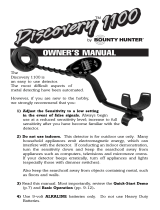 Bounty Hunter 3410006 Owner's manual
Bounty Hunter 3410006 Owner's manual
-
Bounty Hunter DISCOVERY 1100 Owner's manual
-
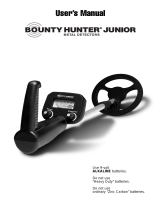 Bounty Hunter Jr. Owner's manual
Bounty Hunter Jr. Owner's manual
-
Bounty Hunter DISCOVERY 1100 Owner's manual
-
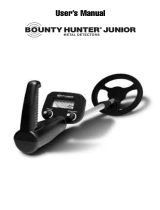 Bounty Hunter BHJS Owner's manual
Bounty Hunter BHJS Owner's manual
-
 Bounty Hunter 3410013 Owner's manual
Bounty Hunter 3410013 Owner's manual
-
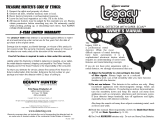 Bounty Hunter LEGACY 3300 User manual
Bounty Hunter LEGACY 3300 User manual
-
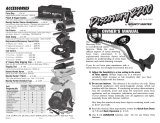 Bounty Hunter Discovery 2200 Flipped Owner's manual
Bounty Hunter Discovery 2200 Flipped Owner's manual
-
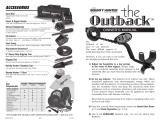 Bounty Hunter Outback Owner's manual
Bounty Hunter Outback Owner's manual
-
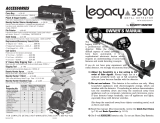 Bounty Hunter Legacy 3000 Owner's manual
Bounty Hunter Legacy 3000 Owner's manual
Other documents
-
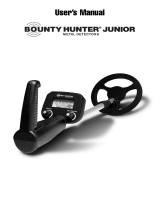 Gold Digger BHJS Operating instructions
Gold Digger BHJS Operating instructions
-
 CLC 27540301 Installation guide
CLC 27540301 Installation guide
-
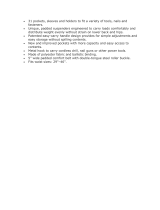 CLC 27540749 Installation guide
CLC 27540749 Installation guide
-
Barska BE12596 Owner's manual
-
Shenzhen MD-3010? User manual
-
Kogan KA3MTANDETA User guide
-
Platinum HAIN3150 User manual
-
 Urbanworx UX-10MDW User manual
Urbanworx UX-10MDW User manual
-
Platinum GC-1037 User manual
-
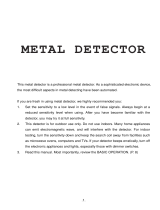 American Hawks METAL30 Owner's manual
American Hawks METAL30 Owner's manual
































